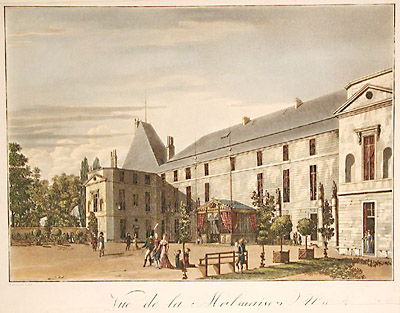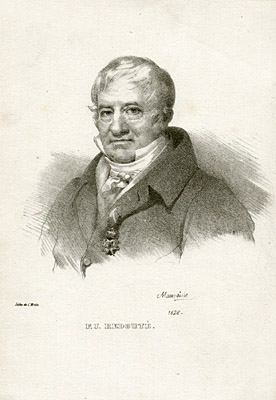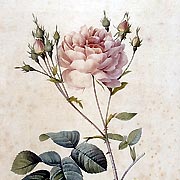 During the Regency, the French and most importantly the Empress Josephine had a significant impact on the development of the rose garden.The Empress Josephine collected roses for her gardens at the Chateau de la Malmaison from 1805 to 1810. This collection gave the French an interest in the culture of roses in the vicinity of Paris that lead to some of the most important work in rose hybridization during the early years of the 19th century.
During the Regency, the French and most importantly the Empress Josephine had a significant impact on the development of the rose garden.The Empress Josephine collected roses for her gardens at the Chateau de la Malmaison from 1805 to 1810. This collection gave the French an interest in the culture of roses in the vicinity of Paris that lead to some of the most important work in rose hybridization during the early years of the 19th century.The French writer, De Pronville, stated that in 1814, there were only about 182 varieties of roses, but by mid-century due the keen interest in the rose and hybridization, there were 6,000 varieties--most created by cross-pollination and the resultant seed production. The gardener of the Empress Josephine was a Frenchman named Dupont and he, along with Vilmorin and Descement were among the earliest cultivators of roses from seed.
The Empress Josephine had over 150 different Gallica cultivars in her collection, and as you may guess, the Gallica was the 'darling' of the Regency period.
When the allied armies entered Paris in 1815, Descement's garden contained 10,000 seedling roses which Vibert, succeeded in saving and carrying to his garden on the Marne in the countryside of France.
The Empress Josephine's goal with Malmaison was to obtain every species of rose then known. Napoleon instructed the French Navy to seize any plants or rose seeds they found when they searched ships at sea. In just one year, Josephine spent close to 2,600 pounds with the English nursery of Kennedy and Lee, despite the war with Britain. Despite the naval blockade, the British Admiralty granted a safe-conduct pass to the Kennedy and Lee firm to deliver the new China Roses to Malmaison. The Englishman Kennedy was employed by the Empress to assist them in laying out her rose garden and interestingly enough, there was one plan (never used) that laid out a rose garden in a design close to the Union Jack.
Josephine set the standard for rose gardening for a very long time. All the wealthy French followed her lead and many joined in the competition to see who could amass the largest collection. Her influence was felt across the Channel, in England, as well. The English, anxious to keep up with social fashion, made concerted efforts to collect roses, just like the French.
Her biggest rival was the Countess of Bougainville, who tried to amass as many new roses as possible. It is no surprise that economically, the rose became the most important flower in France.
After her death, the gardeners who helped create Malmaison went to other positions throughout France and established gardens and nurseries which still have an impact on the rose industry today.
After her death in 1814, Malmaison quickie fell into neglect, but roses still passed from Britain to France.
Many of the men who trained at Malmaison went on to become rose hybridizers and they established France as the premiere country in rose-breeding. During Josephine's residence at Malmaison, Dupont amassed nearly 260 rose species and cultivars. Dupont passed on this legacy toAlexandre Hardy, who took over the Luxembourg Garden and raised many roses we still grow today, including 'Mme. Hardy' and 'Safrano'. Hardy took on a young assistant at the Luxembourg Garden, Jacques-Julien Margottin, who also founded his own rose nursery. He and his son Jules kept alive Josephine's dream and continued to grow and hybridize roses.
These gardens were probably the most important factor in establishing the popularity
 of the rose in the 19th century. Part of Josephine's efforts at Malmaison included commissioning the painter, Pierre-Joseph Redoute to paint the roses in her collection. He had been the court painter to Queen Marie-Antoinette, but despite the revolution, he managed to survive and become the court rose painter.
of the rose in the 19th century. Part of Josephine's efforts at Malmaison included commissioning the painter, Pierre-Joseph Redoute to paint the roses in her collection. He had been the court painter to Queen Marie-Antoinette, but despite the revolution, he managed to survive and become the court rose painter. 
Redoute's work, Les Roses, was completed after Josephine's death, the three volumes, issued between 1817 and 1824 is one of the most beautiful and important books ever published on roses. Botanist Claude-AntoineThory provided the commentary for the book and these volumes became the standard reference work on roses for quite some time. It is still used as a reference work to identify older varieties of roses. Thory made the first serious attempt to untangle the genealogy of roses. Much of his work has proven to be accurate and still stands up today.
Many of the 170 roses illustrated by Redoute are still grown in garden today. Many consider his painting of 'Blush Noisette' to be the all-time masterpiece of botanical illustration.
Even after the exile and death of Napoleon, Redoute continued to paint for Louise-Philippe, the new Bourbon king, in 1830. Redoute died in 1840 at 81 years old. He was painting a lily at the time.
Others carried on the work of cataloguing and growing roses. Prevost, Pepinieriste a Rouen wrote "Catalogue descriptif, methodique et raisonne de especes, varietes et sous-varietes du genre rosier', which listed 880 names of roses.
There were two very famous Englishmen who specialized in roses: Thomas Rivers and William Paul. Rovers wrote: Rivers's Rose Amateur's Guide in 1837, which lists current varieties and cultivation methods. Paul's The Rose Garden was written in 1848 which included a rather pompous essay about the rose in Art, as well as how to cultivate the rose. He describes 87 Damask, 76 Provence (Centifolia), 84 Moss and 471 French (Gallica) roses. As I mentioned earlier, the Gallica rose was really the darling of the 1st half of the 19th century.
But, sadly, tastes changed rapidly. By 1896, George Paul (a nephew to William Paul) wrote in RHS Journal, "Wanted: a refuge for the old roses where they may be found gain when tastes change." There were many wonderful, sumptuous, hardy Old Roses roses raised during the early years of the 19th century, including: 'Mme Hardy' - 1832; 'Felicite Parmentier' - 1836; 'Cardinal de Richelieu' - 1840; 'La Ville de Bruxelles' - 1849; and 'Tour de Malakoff' - 1856. Their heyday of popularity was around 1810 to 1830 and had they not been so vigorous and simply gorgeous, they might have perished with the emergence in mid-century of the remontant varieties.
No comments:
Post a Comment